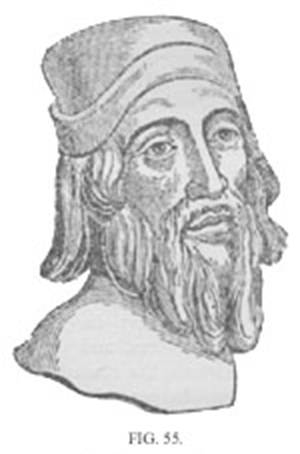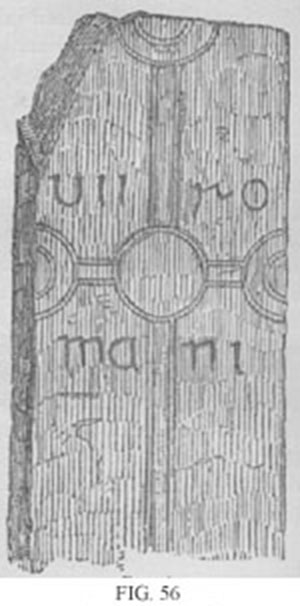Irish Monastic Schools
From A Smaller Social History of Ancient Ireland 1906
« previous page | contents | start of chapter | next page »
CHAPTER VII....continued
2. Monastic Schools.
Two Classes of Schools.—The schools and colleges of ancient Ireland were of two classes, Ecclesiastical and Lay. The ecclesiastical or monastic schools were introduced with Christianity, and were conducted by monks. The lay or secular schools existed from a period of unknown antiquity, and in pagan times they were taught by druids. The Irish monastic schools were celebrated all over Europe in the Middle Ages: the lay schools, though playing an important part in spreading learning at home, were not so well known. These two classes of schools are well distinguished all through the literary history of Ireland, and, without interfering with each other, worked contemporaneously from the fifth to the nineteenth century.
General Features of Monastic Schools.—Even from the time of St. Patrick there were schools in connexion with several of the monasteries he founded, chiefly for the education of young men intended for the church. But when the great monastic movement already spoken of (p. 138) began, in the sixth century, then there was a rapid growth of schools and colleges all over the country: for almost every large monastery had a school attached. Many of these contained great numbers of students. Under each of the three fathers of the Irish Church, St. Finnen in Clonard, St. Comgall in Bangor, and St. Brendan in Clonfert, there were 3000, including no doubt monks as well as students; St. Molaise had 1500; St. Gobban, 1000; and so on down to the school of Glasnevin, where St. Mobi had 50. This last—fifty—was a very usual number in the smaller monastic schools. How such large numbers as those in Clonard, Bangor, and Clonfert obtained living and sleeping accommodation will be found described farther on.
In these schools secular as well as ecclesiastical learning was carefully attended to; for besides divinity, the study of the Scriptures, and classics, for those intended for the church, the students were instructed—as we shall see—in general literature and science. Accordingly, a large proportion of the students in these monastic schools were young men—amongst them sons of kings and chiefs—intended, not for the church, but for ordinary civil or military life, who attended to get a good general education. Those great seminaries were in fact the prototypes of our modern universities.
Extent of Learning in Monastic Schools.—We have ample evidence that both the Latin and Greek languages and literatures were studied with success in Ireland from the sixth to the tenth century; and that the learned men from the Irish schools were quite on a par with the most eminent of the Continental scholars of the time, and not a few of them at the head of all. Columbanus, Aileran the Wise, Cummian, Sedulius, Fergil the Geometer, Duns Scotus, and many others, all Irishmen, and educated in Irish schools, were celebrated throughout Europe for their learning. The most distinguished scholar of his day in Europe was John Scotus Erigena ('John the Irish Scot'), celebrated for his knowledge of Greek, and for his theological speculations. He taught Philosophy in Paris, and died about the year 870.
FIG. 55. John Scotus Erigena
Foreign Students.—In all the more important schools there were students from foreign lands, from the Continent as well as from Great Britain, attracted by the eminence of the masters and by the facilities for quiet, uninterrupted study. In the Lives of distinguished Englishmen we constantly find such statements as "he was sent to Ireland to finish his education." The illustrious scholar Alcuin, who was a native of York, was educated at Clonmacnoise. Among the foreign visitors were many princes: Oswald and Aldfrid, kings of Northumbria, and Dagobert II., king of France, were all educated in Ireland. We get some idea of the numbers of foreigners from the ancient Litany of Aengus the Culdee, in winch we find invoked many Romans, Gauls, Germans, and Britons, all of whom died in Ireland. To this day there is to be seen, on Great Aran island, a tomb-stone, with the inscription "VII Romani," Seven Romans. It is known that in times of persecution Egyptian monks fled to Ireland; and they have left in the country many traces of their influence. In the same Litany of Aengus mention is made of seven Egyptian monks buried in one place.
FIG. 56. Tomb-stone of the Seven Romans in Aran
The greatest number of foreign students came from Great Britain—they came in fleet-loads,as Aldhelm, Bishop of Sherborne (A.D. 705 to 709), expresses it in his letter to his friend Eadfrid, Bishop of Lindisfarne, who had himself been educated in Ireland. Many also were from the Continent. There is a remarkable passage in the Venerable Bede's "Ecclesiastical History" which corroborates Aldhelm's statement, as well as what is said in the native records, and indeed in some particulars goes rather beyond them. Describing the ravages of the yellow plague in 664, he says:—"This pestilence did no less harm in the island of Ireland. Many of the nobility and of the lower ranks of the English nation were there at that time, who, in the days of Bishops Finan and Colman [Irish abbots of Lindisfarne, p. 146, supra],forsaking their native island, retired thither, either for the sake of divine studies, or of a more continent life. . . . The Scots willingly received them all, and took care to supply them with food, as also to furnish them with books to read, and their teaching, all gratis."
Towards the end of the eighth century, it became the custom to appoint a special head professor—commonly called a Fer-leginn, i.e. 'Man of learning'—to preside over, and be responsible for, the educational functions of the college, while the abbot had the care of the whole institution.


